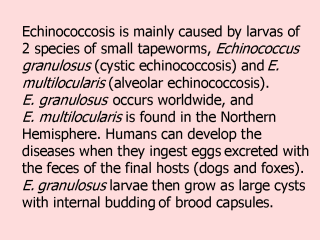 |
E. multilocularis
larva develops by external budding to form an infiltrative growing tumor. In
most cases, the liver is the primary organ affected, whatever the parasite
species. Surgical removal of the parasitic tissue is the most efficient
therapy for the diseases, and the efficiency of antiparasitic drugs depends
upon size of the larvas. Thus, early diagnosis and subsequent treatment may
reduce mortality. As the symptoms vary according to the rate of parasite
growth, the clinical diagnosis of echinococcosis is difficult. There is rarely
any parasitologic evidence of infection. Ultrasound-guided fine-needle
aspiration of the lesions sometimes fails to detect parasites in patients with
alveolar echinococcosis. The distinction between cystic and alveolar
echinococcoses is not always easy in those countries where both species occur
together. |
